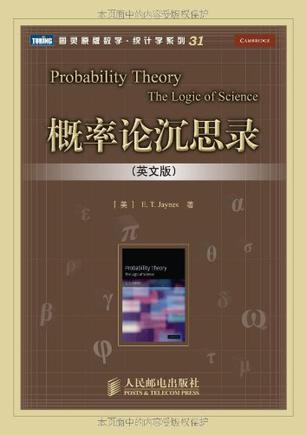概率论沉思录

内容简介:
《概率论沉思录(英文版)》将概率和统计推断融合在一起,用新的观点生动地描述了概率论在物理学、数学、经济学、化学和生物学等领域中的广泛应用,尤其是它阐述了贝叶斯理论的丰富应用,弥补了其他概率和统计教材的不足。全书分为两大部分。第一部分包括10章内容,讲解抽样理论、假设检验、参数估计等概率论的原理及其初等应用;第二部分包括12章内容,讲解概率论的高级应用,如在物理测量、通信理论中的应用。《概率论沉思录(英文版)》还附有大量习题,内容全面,体例完整。 《概率论沉思录(英文版)》内容不局限于某一特定领域,适合涉及数据分析的各领域工作者阅读,也可作为高年级本科生和研究生相关课程的教材。
目录:
PartⅠ Principlesandelementaryapplications 1 Plausiblereasoning 1.1 Deductiveandplausiblereasoning 1.2 Analogieswith slcaltheories 1.3 Thethinkingcomputer 1.4 Introducingtherobot 1.5 Booleanalgebra 1.6 Adequatesetsofoperations 1.7 Thebasicdesiderata 1.8 Comments 1.8.1 Commonlanguagevs.formallogic 1.8.2 Nitpicking 2 Thequantitativerules 2.1 Theproductrule 2.2 Thesumrule 2.3 Qualitativeproperties 2.4 Numericalvalues 2.5 Notationandfinite-setspolicy 2.6 Comments 2.6.1 Suectlvevs.oectlve 2.6.2 G/3delstheorem 2.6.3 Venndiagrams 2.6.4 TheKolmogorovaxioms 3 Elementarysamplingtheory 3.1 Samplingwithoutreplacement 3.2 Logicvs.propensity 3.3 Reasoningfromlesspreciseinformation 3.4 Expectations 3.5 Otherformsandextensions 3.6 Probabilityasamathematicaltool 3.7 Thebinomialdistribution 3.8 Samplingwithreplacement 3.8.1 Digression:asermononrealityvs.models 3.9 Correctionforcorrelations 3.10 Simplification 3.11 Comments 3.11.1 Alookahead 4 Elementaryhypothesistesting 4.1 Priorprobabilities 4.2 Testingbinaryhypotheseswithbinarydata 4.3 Nonextensibilitybeyondthebinarycase 4.4 Multiplehypothesistesting 4.4.1 Digressiononanotherderivation 4.5 Continuousprobabilitydistributionfunctions 4.6 Testinganinfinitenumberofhypotheses 4.6.1 Historicaldigression 4.7 Simpleandcompound(orcomposite)hypotheses 4.8 Comments 4.8.1 Etymology 4.8.2 Whathaveweaccomplished? 5 Queerusesforprobabilitytheory 5.1 Extrasensoryperception 5.2 MrsStewartstelepathicpowers 5.2.1 Digressiononthenormalapproximation 5.2.2 BacktoMrsStewart 5.3 Converginganddivergingviews 5.4 Visualperception-evolutionintoBayesianity? 5.5 ThediscoveryofNeptune 5.5.1 Digressiononalternativehypotheses 5.5.2 BacktoNewton 5.6 Horseracingandweatherforecasting 5.6.1 Discussion 5.7 Paradoxesofintuition 5.8 Bayesianjurisprudence 5.9 Comments 5.9.1 Whatisqueer? 6 Elementaryparameterestimation 6.1 Inversionoftheumdistributions 6.2 BothNandRunknown 6.3 Uniformprior 6.4 Predictivedistributions 6.5 Truncateduniformpriors 6.6 Aconcaveprior 6.7 Thebinomialmonkeyprior 6.8 Metamorphosisintocontinuousparameterestimation 6.9 Estimationwithabinomialsamplingdistribution 6.9.1 Digressiononoptionalstopping 6.10 Compoundestimationproblems 6.11 AsimpleBayesianestimate:quantitativepriorinformation 6.11.1 Fromposteriordistributionfunctiontoestimate 6.12 Effectsofqualitativepriorinformation 6.13 Choiceofaprior 6.14 Onwiththecalculation! 6.15 TheJeffreysprior 6.16 Thepointofitall 6.17 Intervalestimation 6.18 Calculationofvariance 6.19 Generalizationandasymptoticforms 6.20 Rectangularsamplingdistribution 6.21 Smallsamples 6.22 Mathematicaltrickery 6.23 Comments 7 Thecentral,Gaussianornormaldistribution 7.1 Thegravitatingphenomenon 7.2 TheHerschel-Maxwellderivation 7.3 TheGaussderivation 7.4 HistoricalimportanceofGausssresult 7.5 TheLandonderivation 7.6 WhytheubiquitoususeofGausslandistributions? 7.7 Whytheubiquitoussuccess? 7.8 Whatestimatorshouldweuse? 7.9 Errorcancellation 7.10 Thenearirrelevanceofsamplingfrequencydistributions 7.11 Theremarkableefficiencyofinformationtransfer 7.12 Othersamplingdistributions 7.13 Nuisanceparametersassafetydevices 7.14 Moregeneralproperties 7.15 ConvolutionofGaussians 7.16 Thecentrallimittheorem 7.17 Accuracyofcomputations 7.18 Galtonsdiscovery 7.19 PopulationdynamicsandDarwinianevolution 7.20 Evolutionofhumming-birdsandflowers 7.21 Applicationtoeconomics 7.22 ThegreatinequalityofJupiterandSaturn 7.23 ResolutionofdistributionsintoGaussians 7.24 Hermitepolynomialsolutions 7.25 Fouriertransformrelations 7.26 Thereishopeafterall 7.27 Comments 7.27.1 Terminologyagain 8 Sufficiency,ancillarity,andallthat 8.1 Sufficiency 8.2 Fishersufficiency 8.2.1 Examples 8.2.2 TheBlackwell-Raotheorem 8.3 Generalizedsufficiency 8.4 Sufficiencyplusnuisanceparameters 8.5 Thelikelihoodprinciple 8.6 Ancillarity 8.7 Generalizedancillaryinformation 8.8 Asymptoticlikelihood:Fisherinformation 8.9 Combiningevidencefromdifferentsources 8.10 Poolingthedata 8.10.1 Fine-grainedpropositions 8.11 Samsbrokenthermometer 8.12 Comments 8.12.1 Thefallacyofsamplere-use 8.12.2 Afolktheorem 8.12.3 Effectofpriorinformation 8.12.4 Clevertricksandgamesmanship 9 Repetitiveexperiments:probabilityandfrequency 9.1 Physicalexperiments 9.2 Thepoorlyinformedrobot 9.3 Induction 9.4 Aretheregeneralinductiverules? 9.5 Multiplicityfactors 9.6 Partitionfunctionalgorithms 9.6.1 Solutionbyinspection 9.7 Entropyalgorithms 9.8 Anotherwayoflookingatit 9.9 Entropymaximization 9.10 Probabilityandfrequency 9.11 Significancetests 9.11.1 Impliedalternatives 9.12 Comparisonofpsiandchi-squared 9.13 Thechi-squaredtest 9.14 Generalization 9.15 Halleysmortalitytable 9.16 Comments 9.16.1 Theirrationalists 9.16.2 Superstitions 10 Physicsofrandomexperiments 10.1 Aninterestingcorrelation 10.2 Historicalbackground 10.3 Howtocheatatcoinanddietossing 10.3.1 Experimentalevidence 10.4 Bridgehands 10.5 Generalrandomexperiments 10.6 Inductionrevisited 10.7 Butwhataboutquantumtheory? 10.8 Mechanicsundertheclouds 10.9 Moreoncoinsandsymmetry 10.10 Independenceoftosses 10.11 Thearroganceoftheuninformed PartⅡ Advancedapplications 11 Discretepriorprobabilities:theentropyprinciple 11.1 Anewkindofpriorinformation 11.2 Minimum∑Pi2 11.3 Entropy:Shannonstheorem 11.4 TheWallisderivation 11.5 Anexample 11.6 Generalization:amorerigorousproof 11.7 Formalpropertiesofmaximumentropydistributions 11.8 Conceptualproblems-frequencycorrespondence 11.9 Comments 12 Ignorancepriorsandtransformationgroups 12.1 Whatarewetryingtodo? 12.2 Ignorancepriors 12.3 Continuousdistributions 12.4 Transformationgroups 12.4.1 Locationandscaleparameters 12.4.2 APoissonrate 12.4.3 Unknownprobabilityforsuccess 12.4.4 Bertrandsproblem 12.5 Comments 13 Decisiontheory,historicalbackground 13.1 Inferencevs.decision 13.2 DanielBernoullissuggestion 13.3 Therationaleofinsurance 13.4 Entropyandutility 13.5 Thehonestweatherman 13.6 ReactionstoDanielBernoulliandLaplace 13.7 Waldsdecisiontheory 13.8 Parameterestimationforminimumloss 13.9 Reformulationoftheproblem 13.10 Effectofvaryinglossfunctions 13.11 Generaldecisiontheory 13.12 Comments 13.12.1 Objectivityofdecisiontheory 13.12.2 Lossfunctionsinhumansociety 13.12.3 AnewlookattheJeffreysprior 13.12.4 Decisiontheoryisnotfundamental 13.12.5 Anotherdimension? 14 Simpleapplicationsofdecisiontheory 14.1 Definitionsandpreliminaries 14.2 Sufficiencyandinformation 14.3 Lossfunctionsandcriteriaofoptimumperformance 14.4 Adiscreteexample 14.5 Howwouldourrobotdoit? 14.6 Historicalremarks 14.6.1 Theclassicalmatchedfilter 14.7 Thewidgetproblem 14.7.1 SolutionforStage2 14.7.2 SolutionforStage3 14.7.3 SolutionforStage4 14.8 Comments 15 Paradoxesofprobabilitytheory 15.1 Howdoparadoxessurviveandgrow? 15.2 Summingaseriestheeasyway 15.3 Nonconglomerability 15.4 Thetumblingtetrahedra 15.5 Solutionforafinitenumberoftosses 15.6 Finitevs.countableadditivity 15.7 TheBorel-Kolmogorovparadox 15.8 Themarginalizationparadox 15.8.1 Ontogreaterdisasters 15.9 Discussion 15.9.1 TheDSZExample#5 15.9.2 Summary 15.10 Ausefulresultafterall? 15.11 Howtomass-produceparadoxes 15.12 Comments 16 Orthodoxmethods:historicalbackground 16.1 Theearlyproblems 16.2 Sociologyoforthodoxstatistics 16.3 RonaldFisher,HaroldJeffreys,andJerzyNeyman 16.4 Pre-dataandpost-dataconsiderations 16.5 Thesamplingdistributionforanestimator 16.6 Pro-causalandanti-causalbias 16.7 Whatisreal,theprobabilityorthephenomenon? 16.8 Comments 16.8.1 Communicationdifficulties 17 Principlesandpathologyoforthodoxstatistics 17.1 Informationloss 17.2 Unbiasedestimators 17.3 Pathologyofanunbiasedestimate 17.4 Thefundamentalinequalityofthesamplingvariance 17.5 Periodicity:theweatherinCentralPark 17.5.1 Thefollyofpre-filteringdata 17.6. ABayesiananalysis 17.7 Thefollyofrandomization 17.8 Fisher:commonsenseatRothamsted 17.8.1 TheBayesiansafetydevice 17.9 Missingdata 17.10 Trendandseasonalityintimeseries 17.10.1 Orthodoxmethods 17.10.2 TheBayesianmethod 17.10.3 ComparisonofBayesianandorthodoxestimates 17.10.4 Animprovedorthodoxestimate 17.10.5 Theorthodoxcriterionofperformance 17.11 Thegeneralcase 17.12 Comments 18 TheApdistributionandruleofsuccession 18.1 Memorystorageforoldrobots 18.2 Relevance 18.3 Asurprisingconsequence 18.4 Outerandinnerrobots 18.5 Anapplication 18.6 Laplacesruleofsuccession 18.7 Jeffreysobjection 18.8 Bassorcarp? 18.9 Sowheredoesthisleavetherule? 18.10 Generalization 18.11 Confirmationandweightofevidence 18.11.1 Isindifferencebasedonknowledgeorignorance? 18.12 Camapsinductivemethods 18.13 Probabilityandfrequencyinexchangeablesequences 18.14 Predictionoffrequencies 18.15 One-dimensionalneutronmultiplication 18.15.1 Thefrequentistsolution 18.15.2 TheLaplacesolution 18.16 ThedeFinettitheorem 18.17 Comments 19 Physicalmeasurements 19.1 Reductionofequationsofcondition 19.2 Reformulationasadecisionproblem 19.2.1 SermononGaussianerrordistributions 19.3 Theunderdeterminedcase:Kissingular 19.4 Theoverdeterminedcase:Kcanbemadenonsingular 19.5 Numericalevaluationoftheresult 19.6 Accuracyoftheestimates 19.7 Comments 19.7.1 Aparadox 20 Modelcomparison 20.1 Formulationoftheproblem 20.2 Thefairjudgeandthecruelrealist 20.2.1 Parametersknowninadvance 20.2.2 Parametersunknown 20.3 Butwhereistheideaofsimplicity? 20.4 Anexample:linearresponsemodels 20.4.1 Digression:theoldsermonstillanothertime 20.5 Comments 20.5.1 Finalcauses 21 Outliersandrobustness 21.1 Theexperimentersdilemma 21.2 Robustness 21.3 Thetwo-modelmodel 21.4 Exchangeableselection 21.5 ThegeneralBayesiansolution 21.6 Pureoutliers 21.7 Onerecedingdatum 22 Introductiontocommunicationtheory 22.1 Originsofthetheory 22.2 Thenoiselesschannel 22.3 Theinformationsource 22.4 DoestheEnglishlanguagehavestatisticalproperties? 22.5 Optimumencoding:letterfrequenciesknown 22.6 Betterencodingfromknowledgeofdigramfrequencies 22.7 Relationtoastochasticmodel 22.8 Thenoisychannel AppendixA Otherapproachestoprobabilitytheory A.1 TheKolmogorovsystemofprobability A.2 ThedeFinettisystemofprobability A.3 Comparativeprobability A.4 Holdoutsagainstuniversalcomparability A.5 Speculationsaboutlatticetheories AppendixB Mathematicalformalitiesandstyle B.1 Notationandlogicalhierarchy B.2 Ourcautiousapproachpolicy B.3 WillyFelleronmeasuretheory B.4 Kroneckervs.Weierstrasz B.5 Whatisalegitimatemathematicalfunction? B.5.1 Delta-functions B.5.2 Nondifferentiablefunctions B.5.3 Bogusnondifferentiablefunctions B.6 Countinginfinitesets? B.7 TheHausdorffsphereparadoxandmathematicaldiseases B.8 WhatamIsupposedtopublish? B.9 Mathematicalcourtesy AppendixC Convolutionsandcumulants C.1 Relationofcumulantsandmoments




评论